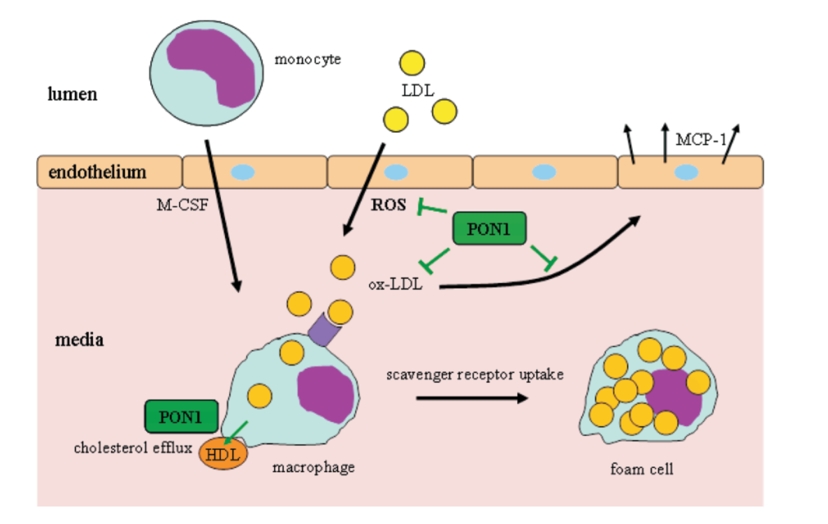What is PON1 Protein
The Paraoxonase 1 (PON1) protein, also known as serum paraoxonase, holds a pivotal role in various biological processes. Its official full name is arylesterase, and it is coded by the PON1 gene. Synonyms for PON1 include serum aryldialkylphosphatase 1 and A-esterase 1. Belonging to the paraoxonase family, PON1 exhibits distinctive structural characteristics, with a molecular weight of approximately 45 kDa. Recent research advances have shed light on its diverse roles, making it a subject of growing interest.
PON1 Biological Functions and Molecular Mechanisms
The biological functions of PON1 are multifaceted, encompassing enzymatic and antioxidant activities. As an esterase, it plays a crucial role in hydrolyzing various substrates, including organophosphates, lactones, and lipid peroxides. PON1's ability to hydrolyze nerve gas agents highlights its significance in detoxification processes.
Moreover, PON1 acts as an antioxidant by preventing the oxidation of low-density lipoproteins (LDL) in the bloodstream. This anti-atherosclerotic property is vital for cardiovascular health, as it impedes the formation of atherosclerotic plaques. The molecular mechanisms underlying these functions involve the catalytic activity of PON1, particularly its capacity to scavenge reactive oxygen species and inhibit lipid peroxidation.

Figure 1. PON1 protective function against foam cell formation and plaque development in atherosclerosis. (Kulka M, et al., 2016)
PON1 Related Signaling Pathway
The signaling pathways associated with PON1 are intricate and involve intricate interactions within cellular networks. PON1's protective effects against atherosclerosis are linked to its ability to modulate inflammation and lipid metabolism. Notably, PON1 has been shown to suppress the nuclear factor-kappa B (NF-κB) pathway, a key player in inflammation. This anti-inflammatory action contributes to its atheroprotective effects.
Moreover, PON1 participates in the regulation of high-density lipoprotein (HDL) functionality, impacting cholesterol efflux and reverse cholesterol transport. These signal pathways highlight the importance of PON1 in maintaining cardiovascular health.
PON1 Related Diseases
The link between PON1 and various diseases underscores its clinical relevance. Altered PON1 activity has been associated with conditions such as cardiovascular diseases, neurodegenerative disorders, and diabetes. Reduced PON1 activity is often observed in individuals with atherosclerosis, leading to an increased risk of cardiovascular events. Additionally, studies suggest a potential role of PON1 in protecting against neurodegenerative diseases by mitigating oxidative stress.
Understanding the interplay between PON1 and these diseases provides valuable insights for diagnostic and therapeutic developments in personalized medicine.
PON1's Applications in Biomedicine
The versatile nature of PON1 has paved the way for its applications in biomedical research and development. Diagnostic tools leveraging PON1 activity as a biomarker have been explored for cardiovascular risk assessment. The assessment of PON1 status provides valuable information about an individual's susceptibility to oxidative stress and related disorders.
In the realm of vaccine development, PON1 has been investigated for its potential as an immunomodulatory agent. Harnessing its enzymatic activity, researchers aim to develop vaccines that can target specific diseases, offering a novel approach to immunization.
Furthermore, PON1 holds promise in therapeutics. Strategies to enhance PON1 activity or deliver exogenous PON1 to individuals with compromised enzymatic function are under investigation. These therapeutic interventions aim to mitigate the risk of atherosclerosis, neurodegenerative diseases, and other conditions associated with oxidative stress.
Recommended Products
| Cat.# | Product name | Species | Source (Host) | Tag |
|---|---|---|---|---|
| PON1-49H | Recombinant Human PON1, His-tagged | Human | E.coli | His |
| PON1-06H | Recombinant Human PON1, His-tagged | Human | Trichoplusia Ni Larval | His |
| PON1-07H | Recombinant Human PON1, His-tagged | Human | E.coli | His |
| PON1-732H | Recombinant Human PON1 Protein (2-355 aa), GST-tagged | Human | E.coli | GST |
| PON1-33H | Recombinant Human PON1 Protein, MYC/DDK-tagged | Human | HEK293T | Myc/DDK |
| PON1-3249H | Recombinant Human PON1 protein, His-tagged | Human | E.coli | His |
| PON1-32H | Active Recombinant Human PON1 Protein, His/Fc-tagged | Human | HEK293 | His/Fc |
| PON1-01H | Active Recombinant Human PON1 Protein, His-tagged | Human | HEK293 | His |
| PON1-1899H | Recombinant Human PON1 Protein, Myc/DDK-tagged, C13 and N15-labeled | Human | HEK293T | Myc/DDK |
| PON1-3299H | Recombinant Human PON1 protein, His-GST-tagged | Human | E.coli | His/GST |
Reference
- Kulka M. A review of paraoxonase 1 properties and diagnostic applications. Polish Journal of Veterinary Sciences. 2016.

